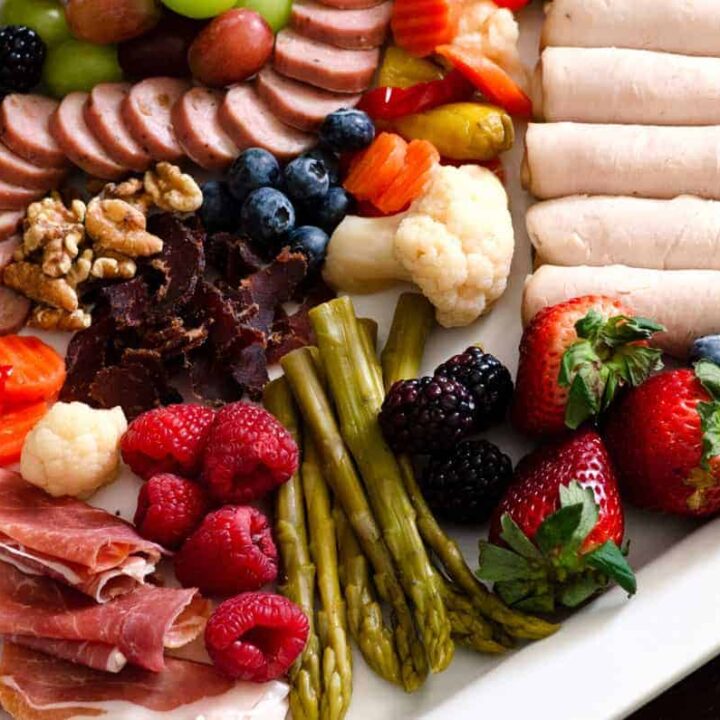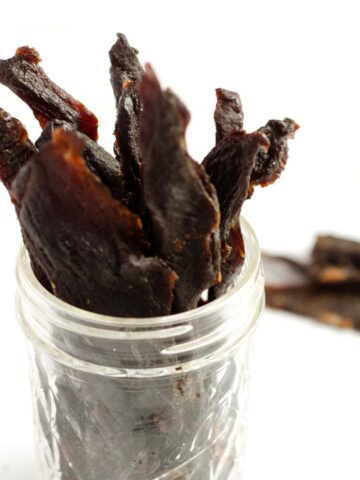This simple Whole30 charcuterie board is the answer to all your Whole30 prayers. No cooking, no cleaning dishes. Delicious flavors and vibrant colors, and the opportunity to include only tastes you love. What more could a Whole 30er want?
What is charcuterie
The word looks odd and sounds even odder, and if you’ve never had the opportunity to be in the vicinity of a charcuterie board, seeing it on a menu might have you raising your eyebrows.
If you’ve ever wondered what the heck a charcuterie board is and why anyone would want to eat one, I've got you covered.
Charcuterie (pronounced "shahr-ku-tuh-ree") is defined as the culinary art of preparing meat products such as bacon, salami, ham, sausage, terrines, galantines, ballotines, pâtés, and confit.
Someone that prepares charcuterie is called a Charcutier. (That's you!)
The history of charcuterie
The word charcuterie originated in France, and it translates to "pork-butcher shop."
While the original French translation refers to pork, many modern charcuterie boards include other types of food like pate, cheese, crackers, fruit, nuts, and dips.
Charcuterie is a culinary art developed from necessity; it is the way meats were preserved long before the days of refrigeration.
And just like pickles, fermented vegetables, home drafted beer, broth and kombucha, charcuterie has been revived and is now found on menus everywhere.
The charcuterie board has been through a bit of a Renaissance in the past few years. It can be easier to think of it like an antipasti platter.
These appetizers are often served at the beginning of a meal at a fancy restaurant or make appearances at cocktail parties and other get-togethers.
They’re often laid out on a wooden board or other large platter and arranged in a way that’s appealing to the eye as well as the nose. Cured meat is the star of the show, and everything else that is included serves to enhance the flavor and texture of the preserved proteins.
While they’ve been around for decades, this recent reawakening of interest in the finger food has restaurants and bars across the U.S. putting their own versions on the menu, some of which can get really creative.
There’s also the option of making your own at home, where you can have all of the freedom to design a board that’s most appealing to you. And when you're on Whole30, you can design a Whole30 charcuterie board and not have to worry if there's anything on it that you can't eat.
You can read more about the history of charcuterie here.
What goes on a charcuterie board
The fabulous thing about making your own charcuterie plate (aside from the fact that it's waaay cheaper than eating one out) is that there are no rules!
You can keep it as simple as you like (just the cured meats maybe?) or dress it up with fresh or dried fruits, olives, nuts, seeds and spreads.
Much like a successful cheese board, the best charcuterie boards feature different flavors, textures, and well-thought-out condiment pairings.
Now, with a Whole30 charcuterie board, we have to make sure everything on the board is Whole30 compliant.
This means that many things commonly found on a charcuterie board can't be included - namely bread, crackers, jams with added sugar, etc.
Things that are IN on your Whole30 charcuterie board:
Meats, fresh and dried fruit, pickled vegetables, olives, nuts and seeds, smoked fish, tapenade or dips.
Remember, these all need to have no added sugar and all Whole30 compliant ingredients, so you have to read your ingredient labels!
A lot of cured meats do have added sugar, but it is not impossible to find those that don't.

Things that are OUT on your Whole30 charcuterie board:
Cheese, crackers (even gluten and grain free one, because SWYPO), added sugars or sweeteners of any kind, anything with added non-Whole30 compliant ingredients.
This has always been hard for me to follow, so I err on the side of caution and just always assume most everything is off limits if I can't pronounce it or don't have it in my kitchen. This is also just a good rule in general to keep junk out of your body!
Whole30 charcuterie board
One of the coolest things about a charcuterie board, in my opinion, is that it is a very tactile eating experience.
No utensils necessary for eating items from a charcuterie board!
When you're on Whole30, all the cooking and dishwashing can get to be tiresome. By the end (ok, let's be honest, after the first week) you don't really want to look at another dish...or the stove.
One of my key hacks for this is leftovers, but this Whole30 charcuterie board is another great answer.
It doesn't require any cooking - at all! Everything can be pulled right out of it's container or package, artfully arranged on a board or plate, and served immediately.
I find it to feel downright luxurious - no cooking, and oh, look, no cleaning either! Just pop that plate in the dishwasher and you're done.
Whole30 charcuterie board ingredients
These are the Whole30 charcuterie board ingredients that I used, shown below. Get creative! You can wander the grocery store and see what you can find for your board.
Remember, this is YOUR Whole30 charcuterie board, so make it your own!
Meats
Applegate Farms sliced deli turkey
Prosciutto (almost always just pork and salt)
Aidells Chicken & Apple Smoked Sausage
Beef Biltong
Fresh fruit
Strawberries
Blackberries
Blueberries
Raspberries
Grapes
Nuts/seeds
Walnuts
Cashews
Pickled veggies
Gardenia mix - cauliflower, carrots, peppers
Pickled asparagus
What else could you include?
Some of my ideas for my next Whole30 charcuterie board include:
Blood orange slices
pickled red onions
pickled carrots
Pistachios
Almonds
Hard boiled eggs
Get creative, and share your ideas in the comments below!
Recipe

Whole30 Charcuterie Board
A simple and easy Whole30 charcuterie board is the easiest way to eat dinner on Whole30! Vibrant colors and your favorite flavors of meats, fruits, and veggies arranged artfully, for a crowd or just you.
Ingredients
- Applegate Farms sliced deli turkey
- Prosciutto
- Aidells Chicken & Apple Smoked Sausage
- Beef Biltong
- Strawberries
- Blackberries
- Blueberries
- Raspberries
- Red and green grapes
- Walnuts
- Cashews
- Pickled asparagus
- Giardiniera mix - pickled cauliflower, carrots, peppers
Instructions
- Arrange all ingredients on a large cutting board or platter in a visually appealing way. There are no wrong answers!
- Chill for serving later, or serve immediately.
- Do NOT do any cooking or dishes. This is a very important step, do not skip it!
Notes
Don't forget to read your labels! It's common for cured meats to have sugar, dextrose, or other additives in them that make them not Whole30 compliant. A great rule of thumb is if you can't pronounce it or you aren't sure what it is, it's best to just steer clear of it. This helps keep junk out of your body in general.
Same rule applies for pickled vegetables - sugar is a common ingredient. You might have to spend a bit more to get some without. Gardineria is usually a safe bet, and priced friendly, but still...read. those. labels.
You can always pickle your own veggies! Just chop, add to a jar, pour over some vinegar, water, and spices you want to add, and stick in the fridge for a day or two. I keep pickled red onions on hand almost all the time. Just leave out the coconut sugar for Whole30.
Nutrition information will vary depending on what you put on your board and how much of it you eat. But honestly, I don't want you worrying about calorie count on Whole30 anyway. Eat when you're hungry. Stop when you're full.
Nutrition Information:
Yield: 4 Serving Size: 1Amount Per Serving: Calories: 300Total Fat: 15gSaturated Fat: 5gTrans Fat: 0gUnsaturated Fat: 8gCholesterol: 64mgSodium: 666mgCarbohydrates: 22gFiber: 6gSugar: 13gProtein: 22g
Need more help for your Whole30? Check out my Whole30 recipe archives here, and all my Whole30 resources here!








Leave a Reply